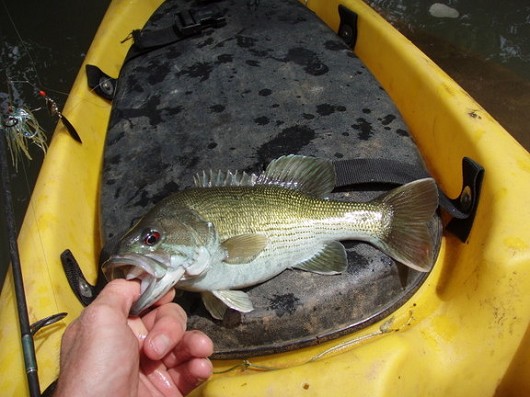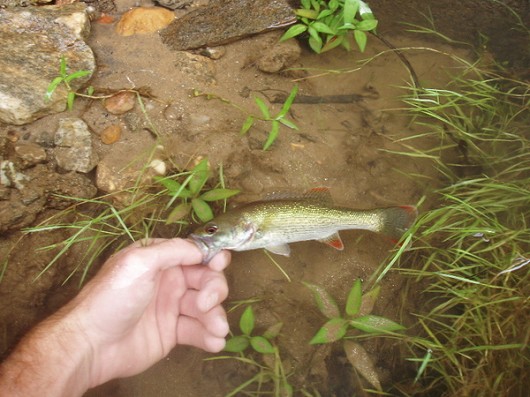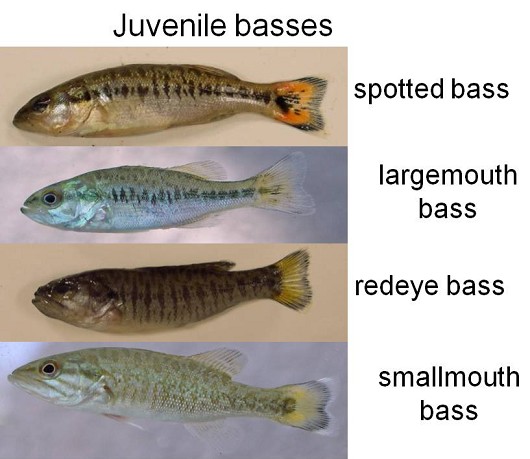Redeye Bass
-
Scientific NameMicropterus coosae
-
NativeNo
-
Identification
 Redeye bass, adult. Caught in eastern USA. Photo courtesy of Drew Gregory.
Redeye bass, adult. Caught in eastern USA. Photo courtesy of Drew Gregory. Redeye bass, juvenile. Photo courtesy of Drew Gregory.
Redeye bass, juvenile. Photo courtesy of Drew Gregory. Juvenile basses. Photos courtesy of Patrick Crain and Scott Matern.
Juvenile basses. Photos courtesy of Patrick Crain and Scott Matern.- Brightly colored with a purplish or greenish cast to the sides, and a distinct white band on the upper and lower edges of the caudal fin
- Reddish eyes (but several other bass species, including Smallmouth Bass and Spotted Bass, may also have red eyes)
- Rows of dark spots on the lower sides and there may be a row of diamond shaped bars along the midline
- Strongly patterned with irregular blotching along the back
- Upper jaw extends to the middle of the eye
- 9-11 dorsal and 3 anal spines
- 11-13 dorsal, 9-11 anal, and 14-17 pectoral fin rays
- 64-73 scales on the lateral line
- Scales on cheek are arranged in 14 rows and are smaller than the opercular scales
- Scales are usually present on the base of the dorsal and anal fin
- Young have distinct vertical bands on their sides that extend below the lateral line and rusty red base of the caudal fin
- Second dorsal, caudal, and front of anal fin brick red on young
-
Life History
Redeye Bass are most common in small, clear, upland streams with pools, pockets of water near boulders and undercut banks, and summer temperatures near 26-28°C. They are also rarely found in reservoirs. Redeye Bass are opportunistic predators, hunting at the surface, in the water column, and off the bottom. Terrestrial insects make up the majority of their diet, but aquatic insects, fish, crayfish, and salamanders are also common prey items. Redeye Bass can make these captures by either ambush or from just cruising around their home area, both methods utilizing a rapid burst of speed that catches the prey off guard. This predator is so skilled that even before reaching adulthood, relatively small Redeye Bass are capable of eating small Mosquitofish.
Maturity is reached when the individual is 12-13 cm long, usually between 2 and 4 years of age. In late spring, when temperatures reach 17-21°C, these adults move up small tributary streams to construct nests. It is believed that mating is similar to that of Smallmouth Bass, where spawning is initiated by a female repeatedly swimming by a male’s nest, changing colors, and keeping her head down in a mating posture. Eventually the pair circle the nest with the male nipping at the female, and the female occasionally rubbing her abdomen on the nest floor. The pair will then settle into the nest and release their eggs and milt simultaneously. While this behavior has yet to be accurately recorded, we do know that redeye bass have fecundities that vary with size, and that females at 15 cm TL average 2,084 eggs per season. These eggs will produce juveniles that grow to 4.5-6.5 cm TL in first year, but take another 9-10 years to reach 25 cm TL. The rare populations that exist in reservoirs grow more quickly and will reach 7-8 cm in a year. Even this measure is much smaller than the growth rates in their native territories, where individuals will reach 22 cm TL by their second year. In California any Redeye Bass greater than 35 cm are believed to be hybrids with Smallmouth Bass.
-
Links to Other ResearchN / A


